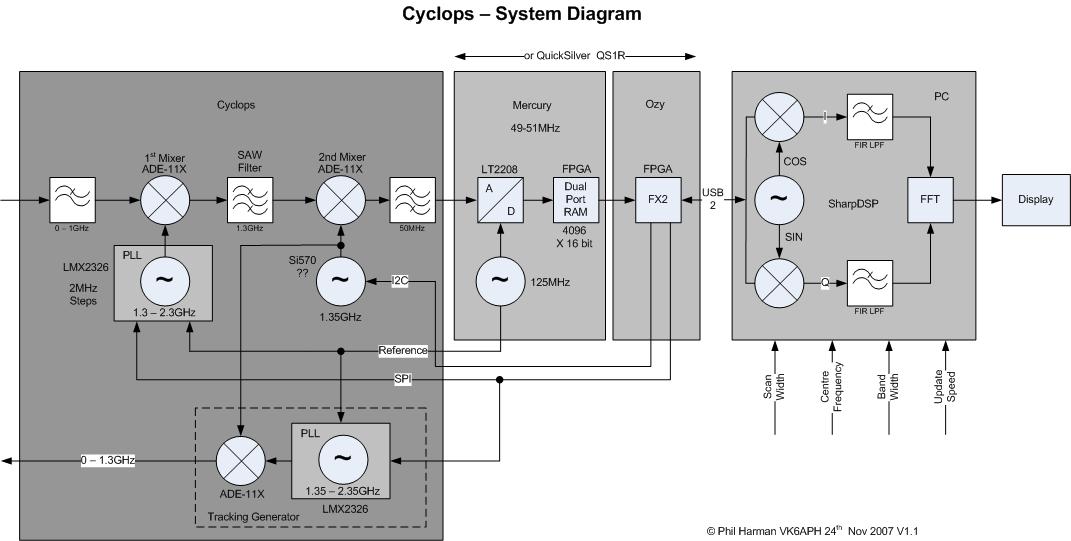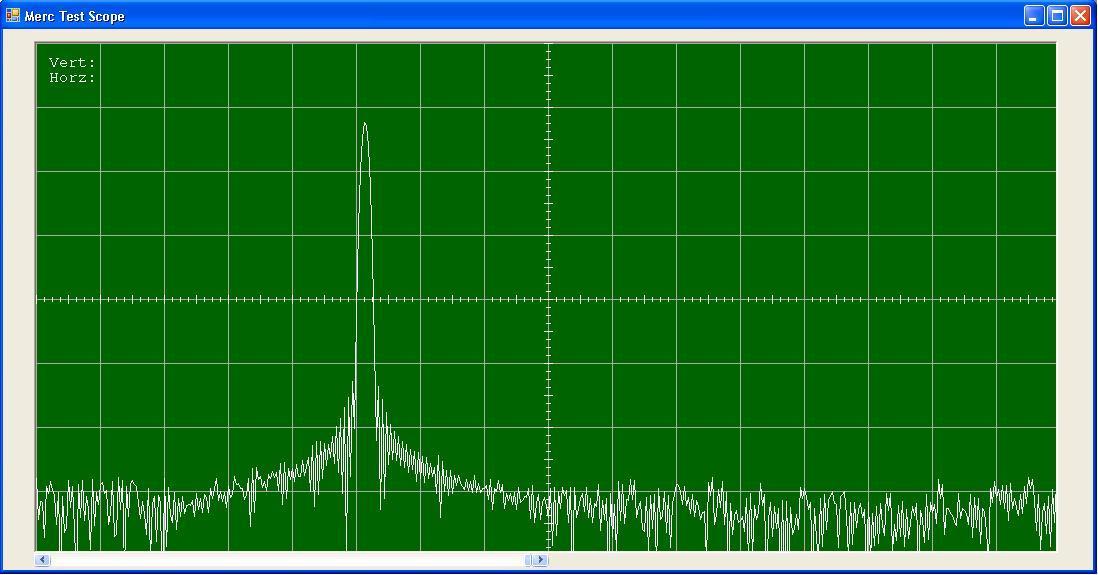Difference between revisions of "CYCLOPS"
| Line 6: | Line 6: | ||
Largely based on Scotty's Spectrum Analyser [SSA] http://www.cpu-net.com/host/wsprowls/ but with a 50MHz second IF based around Mercury or QuickSilver. Moving the second IF to 50MHz simplifies the filtering after the first mixer which means we can most likely use a SAW or Ceramic filter here rather than the multi-stage cavity filter used in the SSA. | Largely based on Scotty's Spectrum Analyser [SSA] http://www.cpu-net.com/host/wsprowls/ but with a 50MHz second IF based around Mercury or QuickSilver. Moving the second IF to 50MHz simplifies the filtering after the first mixer which means we can most likely use a SAW or Ceramic filter here rather than the multi-stage cavity filter used in the SSA. | ||
| − | |||
| − | |||
| − | |||
| − | |||
Please note that the project is intended to develop a spectrum analyser and not a broadband receiver - we will be grabbing a number of samples from the ADC and then processing them at our (PC's) leisure rather than doing this in real-time. | Please note that the project is intended to develop a spectrum analyser and not a broadband receiver - we will be grabbing a number of samples from the ADC and then processing them at our (PC's) leisure rather than doing this in real-time. | ||
| − | |||
| − | |||
| − | |||
| − | |||
Ideas, comments and suggestions are welcome. | Ideas, comments and suggestions are welcome. | ||
73's Phil...VK6APH | 73's Phil...VK6APH | ||
| + | |||
| + | Update: 4 December 2007 | ||
| + | Bill and I have successfully written the necessary software, based on MercScope by Phil N8VB, to display a 48-51MHz chunk of spectrum from Mercury. This represents a working proof of concept as far as the IF is concerned. | ||
| + | |||
| + | Considerable feedback has indicated that basing the software design on C# and Windows based tools was not particularly popular. | ||
| + | There was strong support for a cross platform approach. In which case further development will be undertaken using Java for the GUI (including OpenGL), C/C++ for the processing logic and dttSP for the signal processing. Tom,N4WBS, has agreed to be lead programmer and I am delighted to welcome him to the project. | ||
| + | |||
| + | I have also looked at using a higher 2nd IF, 96MHz rather than 50MHz. This will further relax the specification of the GHz first IF filter and the availability of high performance SAW filters at this frequency will provide sufficient 2nd IF image rejection. The performance of Mercury at this frequency (an alias response) is totally acceptable. | ||
| + | |||
This is a screen shot of the Cyclops PC software processing a simulated input. Frequency span is 0 - 55MHz. A sort of Spectrum Analyzer "Hello World!". | This is a screen shot of the Cyclops PC software processing a simulated input. Frequency span is 0 - 55MHz. A sort of Spectrum Analyzer "Hello World!". | ||
Revision as of 04:19, 5 December 2007
Cyclops - 0 to 1GHz Spectrum Analyzer and Tracking Generator
Largely based on Scotty's Spectrum Analyser [SSA] http://www.cpu-net.com/host/wsprowls/ but with a 50MHz second IF based around Mercury or QuickSilver. Moving the second IF to 50MHz simplifies the filtering after the first mixer which means we can most likely use a SAW or Ceramic filter here rather than the multi-stage cavity filter used in the SSA.
Please note that the project is intended to develop a spectrum analyser and not a broadband receiver - we will be grabbing a number of samples from the ADC and then processing them at our (PC's) leisure rather than doing this in real-time.
Ideas, comments and suggestions are welcome.
73's Phil...VK6APH
Update: 4 December 2007 Bill and I have successfully written the necessary software, based on MercScope by Phil N8VB, to display a 48-51MHz chunk of spectrum from Mercury. This represents a working proof of concept as far as the IF is concerned.
Considerable feedback has indicated that basing the software design on C# and Windows based tools was not particularly popular. There was strong support for a cross platform approach. In which case further development will be undertaken using Java for the GUI (including OpenGL), C/C++ for the processing logic and dttSP for the signal processing. Tom,N4WBS, has agreed to be lead programmer and I am delighted to welcome him to the project.
I have also looked at using a higher 2nd IF, 96MHz rather than 50MHz. This will further relax the specification of the GHz first IF filter and the availability of high performance SAW filters at this frequency will provide sufficient 2nd IF image rejection. The performance of Mercury at this frequency (an alias response) is totally acceptable.
This is a screen shot of the Cyclops PC software processing a simulated input. Frequency span is 0 - 55MHz. A sort of Spectrum Analyzer "Hello World!".
Feedback
Al - N0TVJ - Good web site by S53MV with lots of relevant ideas http://lea.hamradio.si/~s53mv/spectana/vco.html

